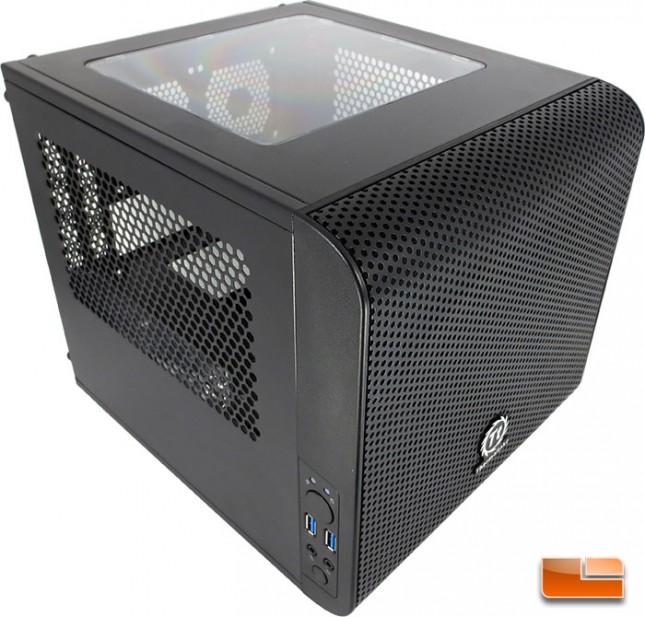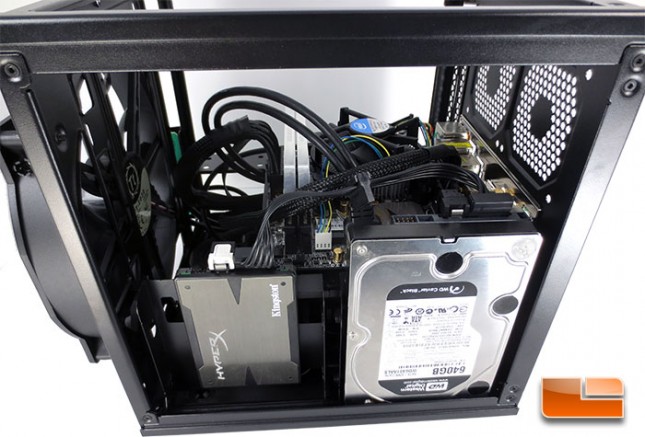Thermaltake Core V1 mini-ITX Chassis Review
Final Thoughts & Conclusion

Over the years I have had a number of Thermaltake cases, ranging from their highend, down to their budget line. There has always been a certain level of consistency with them. Each and every one of the Tt cases that I’ve had has been quality. The Thermaltake Core V1 continued that consistency today. Quality is something that you usually have to pay extra for, though Thermaltake isn’t charging a premium for the Core V1 though, at only $49.99 it’s a great deal!
I was really impressed with the ease that everything fit together inside the Thermaltake Core V1 mini-ITX chassis. One thing I’ve learned with the lower cost cases, it’s almost necessary to wear mechanics gloves so you don’t tear up your hands on the sharp corners and edges. While working inside the Thermaltake Core V1 I didn’t spill a single drop of blood or tear my hands open once! That’s always a selling point in my book. What really sold me on the Thermaltake Core V1 mini-ITX chassis was how roomy it was to work in. Despite being just a hair larger than a mini-ITX motherboard, I had no issues getting my hands into the Core V1 chassis to run the screws in, run the wires, or anything else. All in all it was probably the easiest mini-ITX system build I’ve done to date.

Though I will admit that I was disappointed with the internal drive options, at least at first. Though after thinking about it more, you don’t need much in the way of drive bays in a mini-ITX system. First off, if you’re planning on running a ton of drives, building a mini-ITX system probably isn’t the best choice. If memory serves all of the mini-ITX motherboards that I have looked at only have four SATA ports, granted that’s still two more than the Core V1 is designed to handle. The Core V1 mini-ITX chassis is capable of running a pair of drives, whether they are 2.5″ SSD’s or 3.5″ storage drives you can run two drives. In my personal system I have similar configuration that I show above, I have a SSD for a boot drive and a 3.5″ drive for storage. A number of the Intel Z97 motherboards are also capable of running the latest small form factor SSD, M.2. As the price of SSD’s comes down and the M.2 SSD’s become more available you should be able to run plenty of storage between the two internal drive bays.
The only other feature that I think I would like to see on the Thermaltake Core V1 is the ability to run a dual 120mm radiator. The Core V1 is easily able to fit either a 120mm radiator or a 140mm radiator, but it’s just not designed to handle a radiator that size. Having that ability out of the box would be a selling point, though I could easily see people being able to modify the case side panel to fit one over the top of the drives with very little issues. I suppose it comes down to; if there’s a will, there’s a way!
After using the Thermaltake Core V1 mini-ITX chassis for a few weeks, I’ve come to love it. Don’t tell Thermaltake this, but I would most likely be willing to pay ~$75-$100 for the Core V1 mini-ITX chassis, I definitely think it’s worth it! Fortunately none of us need to as it retails for only $49.99 shipped at Newegg and $49.99 shipped at Amazon!

Legit Bottom Line: The Thermaltake Core V1 is a great chassis if you’re looking to build a mini-ITX system. If you’re looking for a mini-ITX chassis that will fit the latest graphics cards, water cooling, and a full ATX power supply without any issues and with out breaking the bank, at only $50 the Thermaltake Core V1 mini-ITX chassis flat out needs to be at the top of your short list!
